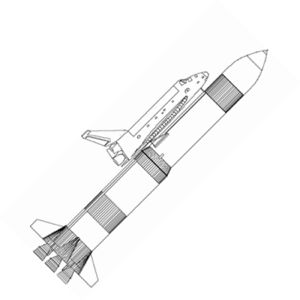
Home - Search - Browse - Alphabetic Index: 0- 1- 2- 3- 4- 5- 6- 7- 8- 9
A- B- C- D- E- F- G- H- I- J- K- L- M- N- O- P- Q- R- S- T- U- V- W- X- Y- Z
Saturn Shuttle
 Shuttle - Saturn 1C Shuttle - Saturn 1C booster Credit: © Mark Wade |
Status: Study 1972. Thrust: 33,737.90 kN (7,584,582 lbf). Gross mass: 3,161,710 kg (6,970,370 lb). Height: 107.00 m (351.00 ft). Diameter: 10.06 m (33.00 ft).
In yet another iteration of shuttle design studies, $ 2.8 million contracts were given in November 1971 to Grumman/Boeing, Lockheed, McDonnell-Douglas/Martin Marietta, and North American Rockwell. The development costs for the Phase B Prime contracts had still been over the Nixon administration's budget cap, and still further ways to reduce development cost had to be found. The studies were to run through 15 March 1972 and study lower cost booster concepts, one of them a Saturn V first stage modified to serve as a flyback booster. The study concluded that a Saturn S-IC flyback booster would need a wing with at least a 700 sq m area, would be powered by five F-1 engines and have a gross mass of 1.6 million kg. Staging would take place at 6450 kph. The vehicle would be reusable, except for the F-1 engines. The use of expendable engines was considered a drawback. The study assumed a series burn, with the shuttle orbiter igniting at altitude.
Flyaway Unit Cost 1985$: 1,020.500 million.
Stage Data - Saturn Shuttle
- Stage 1. 1 x Saturn IC. Gross Mass: 2,286,217 kg (5,040,245 lb). Empty Mass: 135,218 kg (298,104 lb). Thrust (vac): 38,703.160 kN (8,700,816 lbf). Isp: 304 sec. Burn time: 161 sec. Isp(sl): 265 sec. Diameter: 10.06 m (33.00 ft). Span: 19.00 m (62.00 ft). Length: 42.06 m (137.99 ft). Propellants: Lox/Kerosene. No Engines: 5. Engine: F-1. Status: Out of Production.
- Stage 2. 1 x Shuttle Tank. Gross Mass: 750,975 kg (1,655,616 lb). Empty Mass: 29,930 kg (65,980 lb). Isp: 455 sec. Burn time: 480 sec. Isp(sl): 363 sec. Diameter: 8.40 m (27.50 ft). Span: 8.70 m (28.50 ft). Length: 46.88 m (153.80 ft). Propellants: Lox/LH2. No Engines: 0. Engine: None. Other designations: External Tank. Status: Out of production.
- Stage 3. 1 x Shuttle Orbiter. Gross Mass: 99,318 kg (218,958 lb). Empty Mass: 99,117 kg (218,515 lb). Thrust (vac): 6,834.303 kN (1,536,412 lbf). Isp: 455 sec. Burn time: 480 sec. Isp(sl): 363 sec. Diameter: 4.90 m (16.00 ft). Span: 23.79 m (78.05 ft). Length: 37.24 m (122.17 ft). Propellants: Lox/LH2. No Engines: 3. Engine: SSME. Other designations: Shuttle; STS (Space Transportation System). Status: In Production.
- Stage 4. 1 x Shuttle Orbiter OMS. Gross Mass: 25,200 kg (55,500 lb). Empty Mass: 3,600 kg (7,900 lb). Thrust (vac): 53.377 kN (12,000 lbf). Isp: 316 sec. Burn time: 1,250 sec. Diameter: 4.90 m (16.00 ft). Span: 23.79 m (78.05 ft). Length: 37.24 m (122.17 ft). Propellants: N2O4/MMH. No Engines: 2. Engine: OME. Other designations: Orbital Maneuvering System Pods. Status: In Production. Comments: Two pods, mounted each side of vertical stabilizer, provide propulsion for orbit insertion, maneuver, and de-orbit.
Family: orbital launch vehicle, Winged. Country: USA. Engines: OME, None, SSME. Stages: Saturn IC, Shuttle Orbiter OMS, Shuttle Orbiter, Shuttle Tank. Agency: NASA.
Back to top of page
Home - Search - Browse - Alphabetic Index: 0- 1- 2- 3- 4- 5- 6- 7- 8- 9
A- B- C- D- E- F- G- H- I- J- K- L- M- N- O- P- Q- R- S- T- U- V- W- X- Y- Z
© 1997-2019 Mark Wade - Contact
© / Conditions for Use